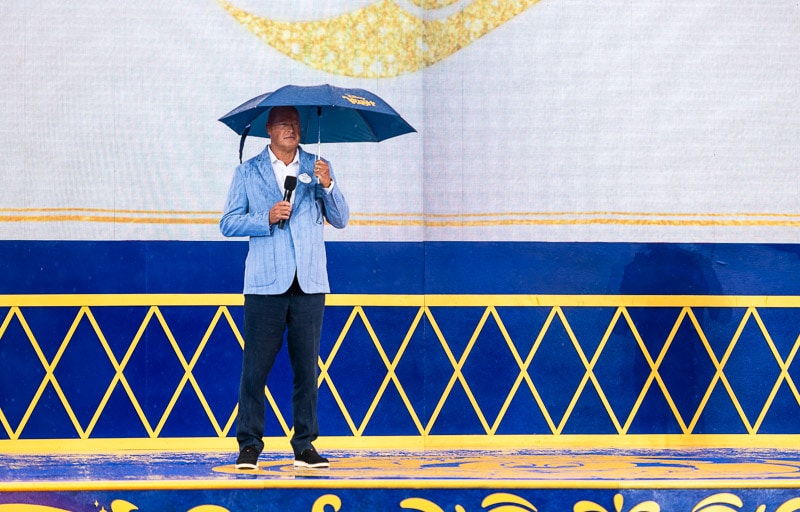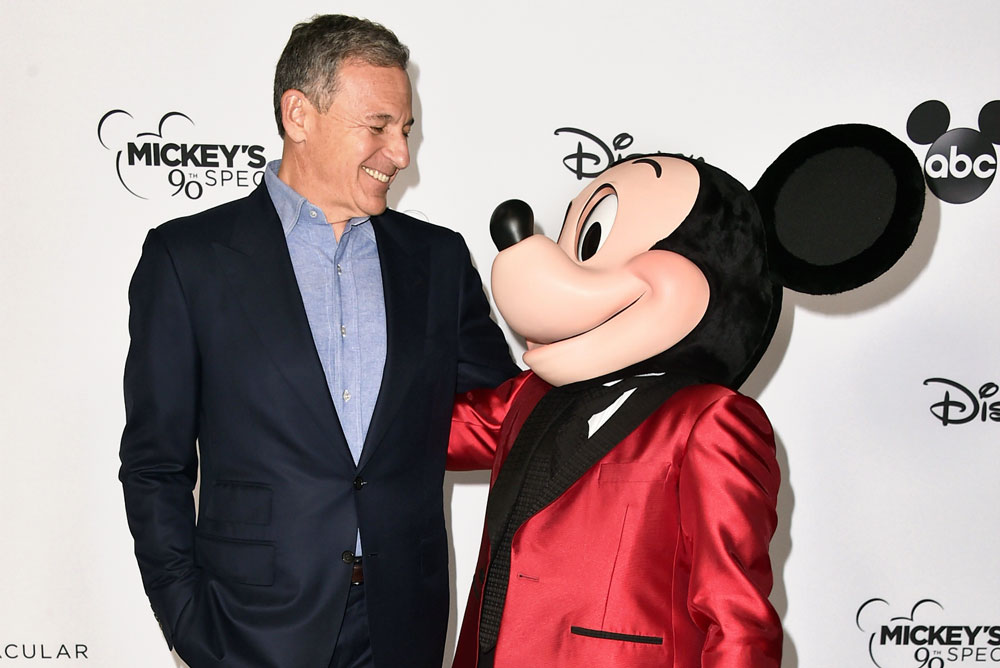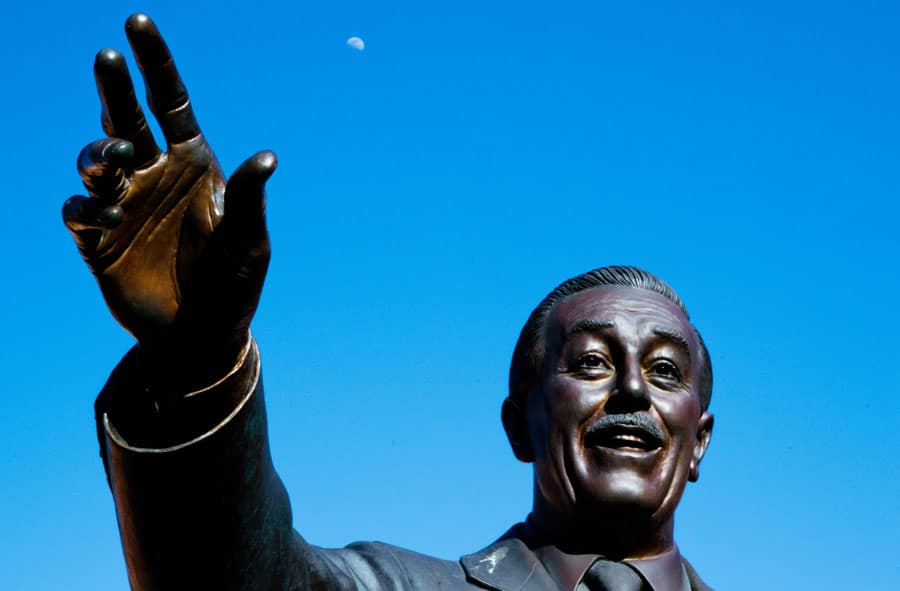Bob Iger Wants Disney Employees Back in Office
Disney’s recently-returned CEO Bob Iger sent a memo to employees requesting those currently with a hybrid work-from-home schedule spend four days a week in-office starting March 1, 2023. This post shares the memo plus our commentary about this move back to in-person work and its underlying motivations, whether it’s a layoff in disguise, and potential implications for Walt Disney World. (Updated February 17, 2023.)
In the memo to Walt Disney Company employees, Bob Iger asked employees currently working a hybrid schedule to spend four days a week on-site, targeting Monday through Thursday as in-person workdays. As justification, Iger emphasized his belief in the benefit of working together in person because “creativity is the heart and soul of who we are and what we do at Disney.”
Iger explained that in a creative business like Disney, “nothing can replace the ability to connect, observe, and create with peers that comes from being physically together, nor the opportunity to grow professionally by learning from leaders and mentors. It is my belief that working together more in-person will benefit the Company’s creativity, culture, and our employees’ careers.”
February 17, 2023 Update: Corporate employees at the Walt Disney Company are pushing back against the new return-to-office (RTO) mandate that will require employees to appear in office four days per week starting in March. According to the Washington Post, more than 2,300 employees have signed an internal petition asking CEO Bob Iger to reconsider the mandate.
This sets up a clash between employees and the corporation over the RTO mandate, which ranks among the strictest for big companies in the post-pandemic era. Disney employees argue that the mandate is “likely to have unintended consequences that cause long-term harm to the company.” The petition signees include corporate employees at ABC, 20th Century Fox, Marvel Studios, Hulu, Pixar, FX, and other divisions.
Disney’s employees argue in the petition that the RTO mandate will lead to “forced resignations among some of our most hard-to-replace talent and vulnerable communities” and also dramatically reducing productivity, output, and efficiency. “This policy will slow, or even reverse, our post-COVID recovery and growth by creating critical resource shortages and causing irreplaceable institutional knowledge loss,” employees wrote in the petition.
There has been no response from Disney about the petition since it was submitted to upper management last week. In other corporate standoffs over RTO mandates, employees have left for different job opportunities or ignored the mandate entirely. However, much of that occurred during a different jobs market, and one where employees enjoyed considerable leverage. Already in 2023, the tides have turned on that and layoffs are becoming more common among white collar workers.
In fact, Disney just announced the company would eliminate 7,000 jobs, which will almost certainly impact its corporate office workers to a disproportionate degree as it’s unlikely to impact frontline theme park Cast Members.
In our prior analysis of the RTO mandate (see below), we contended that it was most likely a layoff in disguise. That was our position before Disney actually announced layoffs, and that news only reinforced our belief. As such, it’s doubtful that the petition signatories will have much success. Threatening to do precisely what the company wants them to do isn’t going to yield favorable results. It might be a different story if this RTO mandate were happening last year and Disney feared losing employees over it, but it’s not and they don’t.
This is one of several big organizational and structural changes that Bob Iger is expected to implement. Upon returning to the Walt Disney Company shortly before Thanksgiving, Bob Iger wasted no time in reshaping the company. His first memo to division leadership days after returning announced restructuring would begin “in the coming weeks.”
As part of that, Kareem Daniel, chairman of Disney Media and Entertainment Distribution and protege of Bob Chapek, was fired. In his memo to DMED, Iger said: “Over the coming weeks, we will begin implementing organizational and operating changes within the company. It is my intention to restructure things in a way that honors and respects creativity as the heart and soul of who we are. As you know, this is a time of enormous change and challenges in our industry, and our work will also focus on creating a more efficient and cost-effective structure.”
This follows Bob Chapek’s memo to executives back in November that “tough and uncomfortable” cost-cutting decisions would be made, including a hiring freeze, layoffs, and other austerity measures. That decision was met with intense internal backlash in Burbank, both for the substance of the news and the way it blindsided many leaders who were not given a heads up about the decision.
Shortly after returning to the helm, Bob Iger held a Cast Member Town Hall and was asked about that hiring freeze. “It felt like it was a wise thing to do in terms of the challenges, and at the moment, I don’t have any plans to change it,” Iger said at the time of the hiring freeze.
We’ll circle back to why this is significant in the commentary. First, here’s Bob Iger’s memo to Disney employees:
Dear Fellow Employees,
Happy New Year! I hope you all found time to rest and recharge during the holidays.
Since returning to Disney, I’ve been busy catching up on the many exciting projects underway across all our businesses, and I have been inspired by your boundless creativity and the remarkable success of so many of your recent endeavors.
I thought I would mention a few:
For the 7th consecutive year, Walt Disney Studios was the number-one studio at the box office, and last week, Avatar: The Way of Water became the 7th highest grossing film of all time, and its success is only continuing to grow. The Lion King celebrated its 25th anniversary on Broadway in November — one of just three productions in history to achieve this incredible milestone. Disney General Entertainment shows received an industry-leading number of mentions across year-end “Best of” lists, including seven of the top 15 most critically acclaimed television shows of the year.
Disney Parks, Experiences and Products finished the year strong as guests celebrated their holiday traditions and rang in the new year at Disney destinations around the world, and Walt Disney Imagineering marked 70 years of groundbreaking innovation and storytelling. And I would be remiss not to mention how the ESPN team expertly handled Damar Hamlin’s tragic injury, showing grace under pressure, and presenting the facts to viewers with utter respect and sensitivity. Accomplishments like these remind me of how special our Company is.
I also wanted to let you know that, as I’ve been meeting with teams throughout the Company over the past few months, I’ve been reminded of the tremendous value in being together with the people you work with. As you’ve heard me say many times, creativity is the heart and soul of who we are and what we do at Disney. And in a creative business like ours, nothing can replace the ability to connect, observe, and create with peers that comes from being physically together, nor the opportunity to grow professionally by learning from leaders and mentors. It is my belief that working together more in-person will benefit the Company’s creativity, culture, and our employees’ careers.
Starting March 1, employees currently working in a hybrid fashion will be asked to spend four days a week on-site, targeting Monday through Thursday as in-person workdays. Stay tuned for additional details.
As we embark on a new year, Disney’s historic 100th anniversary, and all the opportunities before us, we have so many reasons to be excited about the future. Certainly, this is a moment of tremendous change — for our Company, for our industry, and for the global economy — but despite the challenges, at my core I remain an optimist.
Thank you. It’s an honor to be able to work alongside you.
Best,
Bob
When it comes to commentary, this will almost certainly add further fuel to the fire about work-from-home versus on-site offices. That offers a lot to unpack, including the future of employment, whether the pandemic represented a paradigm shift or temporary blip, arguably antiquated beliefs about in-person work and oversight, older v. younger generations of leaders, and so much more.
All of that is incredibly fascinating. Despite having worked remotely for the most part since college (and exclusively since 2014), I have a huge interest in this. It seems like there’s a new article in The Atlantic about WFH on a near-weekly basis, and I’ve read almost all of them. It’s an interesting topic and one that’ll undoubtedly shape the future of work-life balances, parenting, real estate, and so much more.
It’s definitely worth discussing, but not here, since that’s almost certainly not the impetus driving this decision.
Admittedly, this blog has skewed “pro-Iger” since his return to Disney in late November. (Definitely more so than prior to his departure, but part of that was seeing how much worse the alternative was!) With that said, we also have not taken his words at face value, and will not start doing so today.
Bob Iger can attempt to offer as much spin as he’d like about creativity and the benefits of meeting face-to-face or connecting in person. While I don’t doubt that some of that is sincere, I’m also highly skeptical that someone with the leadership chops and vision of Bog Iger actually buys what he’s selling here.
Much more likely is that this is about Chapek’s prior decision to make “tough and uncomfortable” cost-cutting decisions including a hiring freeze and layoffs. While there may not seem to be an ostensible nexus between the two, they are absolutely connected.
Many companies opted for work-from-home or hybrid work models during the pandemic for obvious reasons. Some corporations suggested that this would be permanent–and many employees surmised as much, assuming it was an accelerant to trends already set in motion. Consequently, many employees relocated to areas with cheaper cost-of-living or became accustomed to the lifestyles afforded by remote work.
As things started getting back to normal in late 2021 and early 2022, many companies began looking to bring back staff to offices and return to a more “normal” work environment. By and large, this failed. Workers revolted and threatened to change jobs (or did), and it became exceedingly easy for companies that were all-remote to poach talent from those pushing for in-office work. This resulted in many companies walking back their in-office demands. (Probably no need to over-explain all of this, as it’s been better and more comprehensively covered elsewhere.)
The salient point is that white collar workers who enjoyed the benefits of work-from-home would not return to the office for a variety of reasons. If backed into a corner with an ultimatum, many or most would find new jobs instead.
The key distinction between then and now is that many companies are not overly fixated on losing employees. To the contrary, several major U.S. corporations have announced hiring freezes or layoffs in anticipation of an economic downturn or recession. Many tech firms, including Meta/Facebook, Twitter, Netflix, Amazon, Salesforce, and others have culled their workforces to cut costs. This is being drive by persistent inflation, interest rate hikes, overhiring, and normalizing demand from the height of the pandemic. It has now spilled out beyond the high-growth tech industry, with other companies (Goldman Sachs did so just today) announcing layoffs.
What the Walt Disney Company is doing here is almost certainly aimed at reducing headcount, trimming its number of employees without the unpleasantness of layoffs. It wouldn’t be the first time in recent history–Imagineering’s (supposed) relocation to Lake Nona would be different means to the same end.
In fact, just as layoffs began in the tech industry and have spread to other companies, so too has this practice. Return-to-office mandates have been issued under the guise of greater efficiency, but really are disguised attempts to reduce staffing without layoffs. Employees who refuse to comply are treated as having quit, which allows a company to trim employee ranks without the negative headlines or cost of job cuts.
Given that Disney had a more flexible remote work policy than this for some positions before March 2020 alone suggests it’s not all about creativity, etc. The ultimate “tell” will be whether Disney grants exceptions to this policy–just as it did for the Imagineering relocation–for positions that are more difficult to fill and where employees have greater leverage. If those with more bargaining power are given exceptions, it’ll demonstrate that this is less about corporate culture, and more about evolving realities of the labor market and broader economy.
As for what this means for Walt Disney World visitors…probably not much at all. This also might come as a surprise. If you’ve read even a few posts here over the last two years, you’ve likely heard us blame this or that on staffing shortages. They’re the reason characters have been slow to return, restaurants still aren’t offering all meal services, and so much more. Staffing shortages have become something of a boogeyman (except real) for which we’ve blamed many if not most of Walt Disney World’s operational shortcomings.
While improving tremendously, staffing shortages remain a key impediment to fully normal operations at Walt Disney World. The company has had tremendous difficulty filling certain key roles, and turnover is incredibly high–even as Disney hires aggressively, it has been losing employees almost as quickly as it can onboard them. As a result of this, Disney has left money on the table–because it has literally been able to fill tables at restaurants, offer a full slate of upcharge offerings, etc.
Here, two things can be true at once. The Walt Disney Company wants to reduce its white collar employee headcount and Walt Disney World has a shortage of certain Cast Members in more guest-facing positions.
This in-office mandate will likely apply to employees at Team Disney Orlando (and Anaheim), but it’s not relevant to frontline Cast Members. That much should be obvious, since the waiters at ‘Ohana, ride operators during After Hours at Magic Kingdom, princesses at Akershus–and so forth–never could do any part of their jobs remotely.
Ultimately, it’s possible that Walt Disney World will also slow down the hiring of frontline Cast Members, weary of a shift from pent-up demand to a slowing economy. However, that is not what’s happening here–and it has yet to occur with frontline Cast Members. As of right now, Walt Disney World still has a full slate of open positions it’s trying to fill, including some with hiring bonuses, and has job fairs every Wednesday in January 2023.
Planning a Walt Disney World trip? Learn about hotels on our Walt Disney World Hotels Reviews page. For where to eat, read our Walt Disney World Restaurant Reviews. To save money on tickets or determine which type to buy, read our Tips for Saving Money on Walt Disney World Tickets post. Our What to Pack for Disney Trips post takes a unique look at clever items to take. For what to do and when to do it, our Walt Disney World Ride Guides will help. For comprehensive advice, the best place to start is our Walt Disney World Trip Planning Guide for everything you need to know!
YOUR THOUGHTS
What do you think about the Iger’s memo asking hybrid employees to return to the office? What about Iger’s supposed belief in the benefit of working together in person because creativity is the heart and soul of Disney? Thoughts on this being a layoff in disguise? Are you bullish or bearish about the company’s future as the Walt Disney Company enters its 100th year? Think things will get better or worse throughout 2023? Do you agree or disagree with our assessment? Any questions we can help you answer? Hearing your feedback–even when you disagree with us–is both interesting to us and helpful to other readers, so please share your thoughts below in the comments!













“Currently working in a hybrid fashion” implies that the workers this affects are ALREADY on-site at least one day a week. Obviously, everybody’s situation is going to be different, depending on what field they work in. But if I’m ALREADY on-site at least one day a week, being asked to do four days doesn’t seem unreasonable. Also, I would remind everybody that it’s a benefit to BE SEEN. Your bosses and your coworkers might not recognize just how much you’re doing for the company if they aren’t seeing you do it.
If the company you WORK FOR wants you in the office, you GO TO THE OFFICE. I guess I’m old school but I don’t understand the mentality here. They sign your paycheck, they make the rules people. It’s pretty simple. SMH.
What’s old school is the ‘just be grateful you have a job’ vibe that permeates some of these comments.
Employment is transactional.
In some situations, the employer has the leverage; in other situations, the employees have the leverage. In the last year, other RTO mandates have been walked back because employees threatened to quit–or too many did leave. In this scenario, I think it’s a miscalculation by Disney’s employees to think this will have the same result, as it’s a different labor market now as compared to 8-12 months ago.
… or you can leave, or threaten to leave. This will be negotiated and an equilibrium will be reached. Too bad you weren’t able to negotiate this in your favor, but that doesn’t mean other workers can’t.
My grandfather used to tell me when I was reaching the employable age, “whoever pays you the money gets to make the rules. You only have one card to play if you don’t like it”. I think some employees that feel otherwise, just have not experienced hunger yet.
It’s much easier to control access to company property, real and intellectual, if employees that utilize said property are located on site. Controlled access to the work
facility is easily monitored. Access to your workstation in your home, while you were taking a lunch break at the local sub shop and didn’t “lock” your computer is not. The company does not have control over who could gain access to your workstation thru your negligence…, or maybe even your cooperation.
My opinion is why does it have to be all or nothing with both companies and office employees. At my office we found a middle ground where we work from home 1, 2 or 3 days a week and the other days we are in the office. I work in IT and I literally can do my job 90% from home and my productivity has not diminished, because believe me my boss would let me know. LOL I totally believe that employee’s should definitely go into the office 2-3 days a week and that this is a very fair schedule. I have been working 2-3 days from home since covid and I can say that there is a lot of positives to being able to work with co-workers face-to-face, but I also have realized that you do not need to do it 5 days a week and being away from the office distractions is also a big plus.
As much as we want to, we cannot pretend like the world is the way it used to be. It is very very expensive to live in half an apartment and even afford basic things and by doing this, you condemn people to not even have those things, but even afford that apartment be homeless and it’s cruel and it’s wrong. Cast members need at least $20 an hour to live and afford basic necessities in Orlando when a one bedroom is 1500 a month
I’m guessing this comment is in response to the union standoff with Walt Disney World? The employees being called back to the office have median salaries much higher than $20/hour.
Not surprising.. I work for a large global corporation that is tech heavy, and the results are pretty clear in the last 12 months or so from our internal analysis– any productivity gains / maintains that occurred post COVID during WFH have evaporated in the past year and are now trending negative, except for a couple small niche spots. Additionally, we have found that on-boarding new employees and getting them integrated into company culture and processes is nearly impossible with an inflated WFH structure. This isn’t a “get off my lawn” or “Okay boomer” dichotomy… the ability to effectively manage and get productivity out of a WFH workforce is extremely hard and probably only operational in a very small portion of the economy / businesses.
Interesting insight–thanks for sharing that!
I am unquestionably biased, but I still think there’s value in a WFH structure for some occupations or industries. For others, not so much.
I also don’t think analysis at this point can possibly tell the full story. Early on, workers were likely terrified of losing their jobs, or invested in ‘proving’ that the new paradigm could work. More recently, there’s probably a mix of burnout and more widespread knowledge of the stronger jobs market (even as the tides have been turning).
Of course, that’s entirely speculative and certainly doesn’t undercut actual objective analysis. I just wish the WFH shift could’ve occurred more organically to see if it’s really sustainable, and what the pros & cons are of the approach. Instead, we’re ping-ponging around, it seems.
You hit the nail on the head Tom. The tides have turned for the non-front line staff. The employees that signed this petition won’t be employed by Disney much longer…either by their own choice or by Disney’s hand. Either way, Disney ends up exactly where they are trying to be with headcount.
I worked for a company back when I was 20 in which I worked 7 days a week, 7 am to 7pm. My Mom and Dad worked 7 days a week, 7 different jobs between them, as they raised 5 children. These crybabies, crying about a 4 day work week would have NEVER habmve made it in the 70s and 80s. They should get on their knees and thank GOD every day that they live in a time where Americans seem to embrace the slothful and coddle the lazy. If I were Bob, anyone who signs that petition, I would IMMEDIATELY fire them. Never thought I’d live to see a day when employers have to beg for their lazy, slothful, ungrateful employees to return to work for ONLY 4 DAYS A WEEK! SHAMEFUL! PATHETIC!
I’m astonished and disheartened that a comment like this is permitted. But I hope Tom won’t delete it because it will only embolden Jimmy to claim he’s being canceled. I would prefer to rebut it. One: your comment about a four-day work week is materially false as, from what I can tell, they are still expecting five days a week, just that four of those require physical presence in the office. So no, it’s not a four-day work week. Two: You couldn’t secure a better job/working conditions, so now you wish to take out your frustrations on the people who can and do. There are still many jobs out there that demand unreasonable hours in suboptimal conditions for poor pay. But there are also those of us who know what our worth is and we seek out reasonable hours in optimal working conditions for decent pay. That’s not a badge of shame, far from it. I would be more bemused if, with all my knowledge and skills, the only job I could get is one that requires me to work 84-hour weeks to survive. Three: your parents made the choice to have five kids when the only way they could afford to finance them was working 7 jobs. Again, blaming others for personal choices is hardly a model of responsibility and resilience.
Why be “astonished and disheartened that a comment like this is permitted” when you’ve also concluded that doing so would only embolden the commenter–and his assertions are easily rebutted?
Given that I’ve responded to a subsequent commenter, one could’ve concluded that I saw this comment and didn’t even believe it necessitated a response…
Right on. It’s really astounding.
Curious to know if this will apply to people that work remotely for the company and live in states that have no corporate offices in the area.
There might be some attempt at ‘culling the herd.’ But I’m not sure I am totally on board with that idea. Disney may seem like a great place to work on the outside but from reading various articles on the culture there I am not sure that it’s a great place to work if you are a white collar worker. Some of this, in my opinion, is old-school management trying to reassert its authority with the blessing of Iger,
And, as mention above in the article, workers can vote with their feet, especially IT workers.
And…I just read an interesting article in WSJ today of another proxy fight at Disney
***
Nelson Peltz Plans Proxy Fight Against Disney
Trian Fund Management wants Disney to plan for Robert Iger’s successor and wants a seat on the board
****
Trian thinks Disney has excessive compensation practices and lacks cost discipline, the people said. The firm is also critical of Disney management’s judgment in recent deal-making efforts, including by overpaying, in its view, for the assets of 21st Century Fox Inc. and bidding aggressively for pay-TV giant Sky PLC, the people said. Fox’s corporate sibling, News Corp, owns The Wall Street Journal.
Disney is going to really struggle to retain employees in the areas of IT, customer service, and marketing. These are areas where WFH positions are plentiful in industries across the board. I was actually chatting with a customer service rep in a specific branch of Disney last week and she said they were understaffed AND one of the few teams required to be in office every day.
The problem with this type of method for culling out employees who don’t want to come into the office, is you’re likely going to lose your top employees instead of your low performers–because they know they have options elsewhere.
I tend to have strong feelings on this subject, as someone who has worked remotely as a writer since 2016. I have much more uninterrupted time to write, versus when I was in an office and constantly had people stopping by to say hi, ask questions, or bounce ideas off of me. Same when I was doing graphic design. It is a weird myth that creatives need CONSTANT outside stimulation to do good work.
Yes, call center type roles are basically robots who can work almost anywhere. They should be able to track productivity by number of tickets resolved, calls completed, etc pretty easily and know who needs to be fired. And I would agree with you that your niche of solo writing doesn’t need much collaboration in an office environment, but that’s a small portion of creative work. As Tom has said, a majority of Disney CMs are not customer facing or in Imagineering where being in place is a requirement to get things done and for them, having to go into the office every day is maybe not worth it. For most, though, a hybrid model works best. I never would have taken a job where I had to make a crazy commute in the first place, so that’s not really a valid reason to me. It’s a choice those people made. A friend who works for a major tract home builder based in Houston does their IT stuff but he lives way over east of the city and was working from home pretty much 100% before the plandemic. Now that he has to actually drive into the let’s call it Mos Eisley hell of Houston even 2 or 3 days a week, he is miserable about that which is understandable. My brother works from home almost 100%, again doing network management, etc for a major outdoor advertising company worldwide and rarely has to go into an office. He has stuff shipped to the house, programs switches and firewalls, etc, tests them, ships them out via Fedex. He has a 43″ Samsung smart monitor flanked on each side by two 32″ Samsung, all 4K, wall mounted. We call it the TIE fighter configuration for obvious reasons. He is absolutely miserable trying to work from just a laptop on rare occasions he has to go to a site for a phone migration or to physically fix something the commoners cannot do. I have two 24″ and the laptop at my office, but at home I have two of the Samsung awesome 32″ so yeah it’s better for me to work at home too. But when I have to redline drawings for the cad staff who aren’t experienced engineers or architects to draw and explain it, being here in person is an absolute necessity. Or when they can’t read my chicken scratch notes, although I’ve gone to typing the notes out for them often as not because it’s easier for me even though my typing sucks.
Short version, we all have differing situations and there is no magic solution for everyone.
MrNico, completely understand and I agree. My major issue is with companies like Disney issuing blanket Return to Office policies. I actually did work as part of a writing team: I had reports whose writing I had to edit, and certainly had to tap my internal and external networks to get all of the information I needed for the work I did. Still easier to do remote than in person. However, we did have a large video team and they very much had to be on site–mostly because they didn’t have computers at home powerful enough to do the editing, and all of our filming was done in our in-house studio.
The issue is honestly not letting teams handle remote work on a case-by-case basis. I can say from experience it is truly demoralizing to be a high performer who can effectively work from home, and be told you need to commute into an office because that’s just how the boss wants to do it.
I think in the case of Disney a huge deciding factor is the financial one of having all of this real estate, which needs to run some level of facilities/maintenance even if it isn’t occupied. At my previous job, they had been planning to not renew a lease on a rented building and expand remote work days to squeeze everyone into the two buildings they owned, which was a big cost savings. The pandemic just sped up the process of moving everyone out and cleaning the rental. But I’m pretty sure Disney owns most of their offices in CA/FL, so it won’t look good to shareholders to have to pay for buildings (property tax, indoor and outdoor cleaning/maintenance, and utilities) if no one is using them.